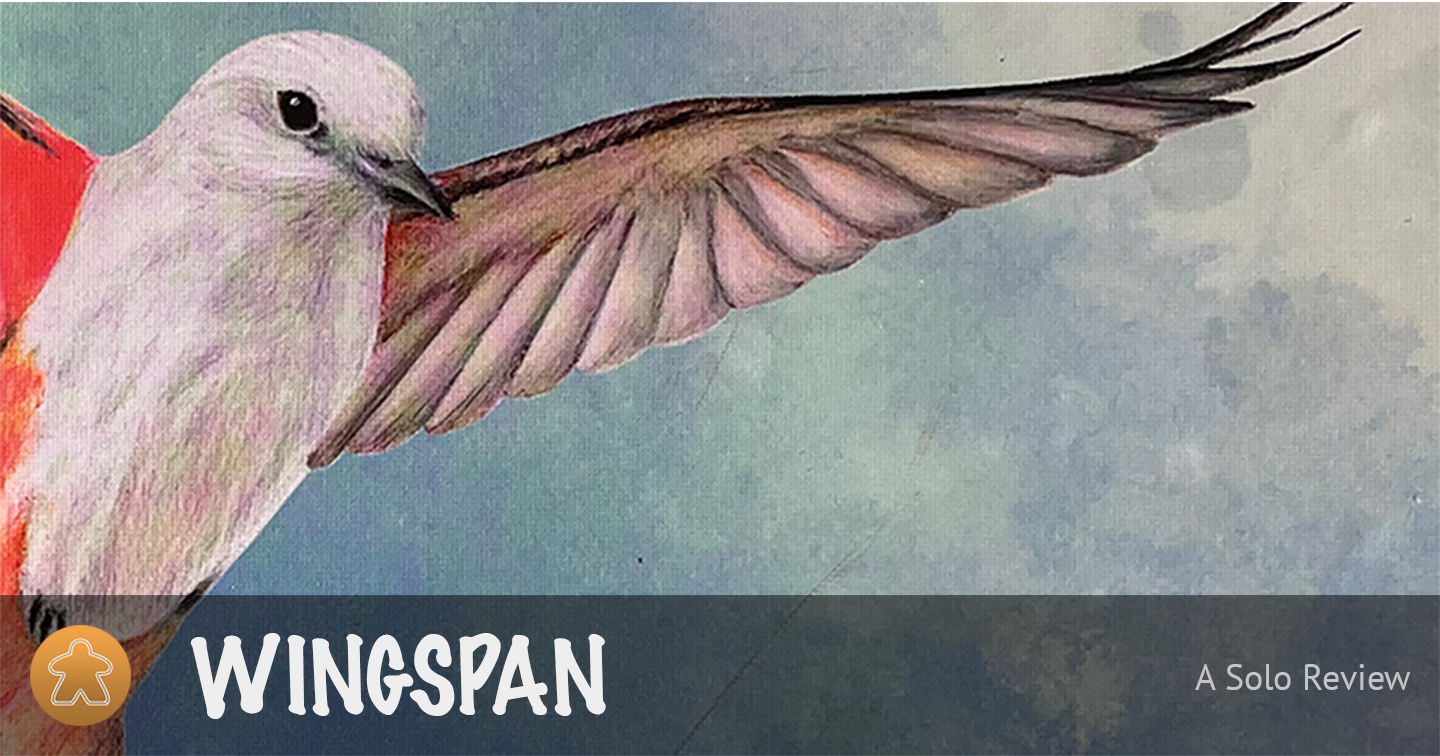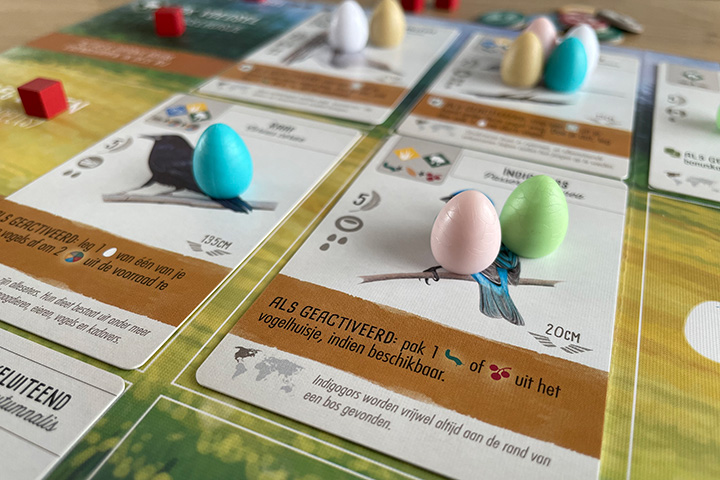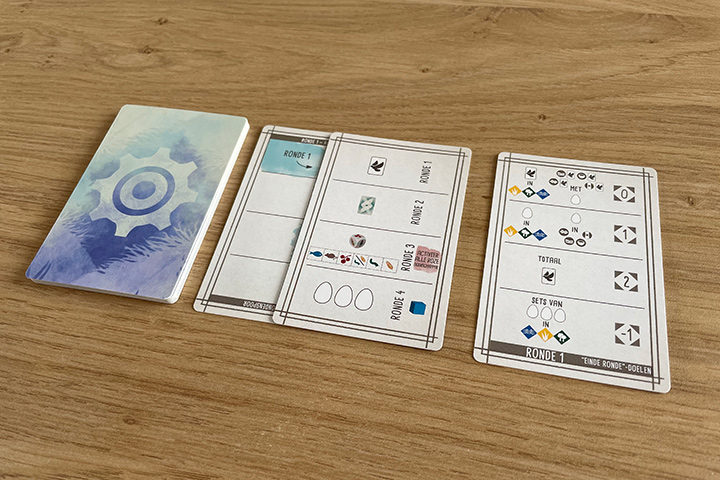Wingspan - A Solo Review
09 Jul 2021
Birds. That sounds like a very niche theme for a board game. Only a handful of people would be into that, right? Wrong! Wingspan is ranked as the 20th best game on Board Game Geek and has conquered the hearts of many, many board games since its release in 2019. What’s up with that?
Name: Wingspan
Designer: Elizabeth Hargrave
Publisher: Stonemaier Games (999 Games, for the Dutch edition I have)
Game type: card drafting, engine building, tableau building
What is Wingspan?
In Wingspan you take up the role of a bird enthusiast trying to find and attract the best birds to your wildlife preserve. Birds come with abilities which can be chained together allowing you to set up an engine. This will enable you to accomplish various things which will score you points at the end of the game: laying eggs, capturing other birds and fulfilling a personal end-of-game goal and shared end-of-round goals.
How does it play?
In the beginning of the game you get five bird cards and five food tokens. Of those ten items, you can only keep five; you have to discard the rest. So that means you could for example keep two birds and three food tokens. Next to that and a player mat, you also get two bonus cards of which you get to choose and keep one. This bonus card describes your personal end-of-game bonus, for example two points per bird you have that eats mice.
On your turn get to choose from only two possible actions. You either add a bird card from your hand to one of the three habitats on your player mat, or you activate one of those habitats.
When you add a bird from your hand to your player mat, which represents your wildlife preserve, you add it to one of the three habitats: forest, grassland or wetlands. Which habitat a bird can go to is indicated on the bird card. The bird goes into the left-most available spot in the habitat and you pay the required amount and type of food as indicated on the bird card. Depending on where in the habitat you place the bird you also have to pay eggs. The more to the right, the more expensive it gets.
The other option is activating one of the three habitats. Each habitat has its own ability. The forest gives you food, the grassland lets you place eggs on your birds and the wetland lets you draw cards. The more birds you have in the habitat you’re activating, the more powerful the ability becomes. For example, if you have no birds in the forest, you can only take one die from the bird feeder (it’s basically a dice tower). If you have four birds in the forest, you get to take three dice. The icons on the dice you take determine which food tokens you can get from the supply.
But that’s not the only thing that happens when you activate a habitat. After you’ve done the habitat’s ability, you go over your birds in that habitat, from right to left, and you execute the “on activate” ability of each bird. Examples of those abilities are “take a fish token out of the food supply”, “draw two cards, when you do, discard one card from your hand and the end of your turn” or “discard a fruit token to tuck two cards from the deck behind this bird”. This allows for some really clever “engines” where taking the wetlands ability lets you place eggs on your birds, which you can then turn into food or cards via the abilities of your birds in that habitat. Getting food, eggs and cards using only one habitat’s action is way to use your limited set of actions as efficiently as possible.

When you take an action, you place one of your action cubes on the relevant spot on your player mat. When you’re out of action cubes, the round ends and you use one of your cubes to mark your position for the end-of-round goal. Since there are four rounds and you use one of your action cubes to mark each of the goals, you get one less action each round. You start with eight cubes, so you get eight actions in the first round, but only seven in the second, six in the third and five in the final round.
At the end of the fourth round the scoring happens. You get one point per egg on your birds, one point per tucked card, one point per food token on your birds and whatever points you scored for the four end-of-round goals.
Whoever has the most points wins the game.
How does the AI work?
The AI in this game is in the form of an automa deck, developed by Automa Factory. It’s basically a deck of cards and each card contains four different actions, one for each round in the game. At the beginning of the round you shuffle the deck. When it’s the automa’s turn you flip over the top card of the deck and you execute the action for the round you’re in. Easy as that!

The AI doesn’t have its own player mat or hand of cards, but the actions it can do kind of simulate what a real player would do: taking food dice out of the bird feeder so you can’t take them, taking eggs, taking bird cards from the three available face up cards next to the bird deck, …
The AI also has a base value for each of the end-of-round goals. For example, one of the possible end-of-round goals is “most eggs in the forest”. If this is the goal for the first round, the AI will have a base value of one; as if it has one egg in the forest. But if it is the goal for the fourth round, the AI will have a base value of seven; as if it has seven eggs in the forest. One of the AI’s actions is to add a cube to the current end-of-round goal. This allows it to increase the base value so that the AI’s score for each goal isn’t entirely predictable.
The AI scores three, four or five points for face down bird cards it collected, the point values on cards for face up bird cards it collected, one point per egg it collected and of course the points for the end-of-round goals.
There are two ways change the difficultly of the game:
- Choose how many points it scores per face down card: three, four or five.
- Add a special card to its deck to make it a stronger.
I usually play against the medium AI (four points per face down card) and with special card included. I think I win about 60% of the times, which is enough to have some fun while still keeping it challenging. And there’s still room to bump up the difficulty.
What does it look and feel like?
Ok, first of all, the quality of the components is top notch. From what I’ve heard this is typical for Stonemaier games.
The cards have a nice linen finish. I have not sleeved the cards of this game because honestly, they really feel like they don’t need it. Besides, you only need to shuffle most of them once at the start of the game so they won’t have to suffer much abuse. You do need to shuffle the automa cards every turn, but after over a dozen games I still can’t spot any sign of wear and tear, which is not the case for all of my games. Really good quality here.
The eggs have a nice feel to them. They don’t feel like they’re plastic even though they are. They come in a few colors and while the colors don’t have any function during the game, it does make for some variety and adds to the overall feel of the game.
The theme of the game quite relaxing in itself, but the art style really helps as well. The drawings of the birds are very well done and even though there is a fair amount of information on the cards, they don’t feel busy or crowded.
How much time does it take?
According to the box, the game takes between 40 and 70 minutes. My first few games easily took over an hour, but once you get the hang of it I think it is safe to say you’ll be able finish a game in less than an hour, including setup and teardown.
One thing I like about this game is how the setup and teardown is made a lot faster and easier by the different types of game trays that are included in the box. There are four smaller basic ones for the eggs and food tokens. But there’s also a bigger more specialized one that is used for storing the cards and serves as a special holder for the three face up cards during play. Really nice!
Another nice touch is that the side of the game box has a small diagram of how you should place the components back in the box to make everything fit.
What is my verdict?
I didn’t expect to like a game about birds, but I really do. It is such a relaxing game to play against an AI that is super easy to operate and provides a challenge while still being beatable.
The variable setup with the random end-of-round goals, the large selection of end-of-game bonus cards and huge amount of bird cards gives the game a lot of replayability.
The quality of the components gives everything a premium feel, although I have to say the card board dice tower can be a bit fiddly.
One thing that can be a bit annoying is that when you get a bit unlucky with the cards, it can happen that you have to change plans half way through game and that can have a negative impact on your score. Luckily the four end-of-round goals always give you something to work towards so that kind of mitigates that.
I enjoy Wingspan every time I play it and I can highly recommend it to any one who is into light engine and tableau building games looking for a relaxing game that can be played in less than an hour.
Score
To make things easier for myself, I use the same scoring categories Board Game Geek uses.
Comments
I'm sorry, I don't support comments on my website. If you want to discuss the game or my review, feel free comment on this dedicated Instagram post or my review on BGG.